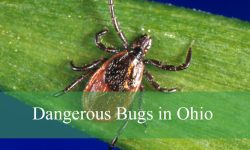Texas is home to a variety of centipede species, each with unique characteristics and behaviors. These many-legged arthropods play important roles in local ecosystems by preying on insects and other small invertebrates. While some centipedes are harmless, others can deliver painful bites, so knowing which species you might encounter is helpful.
Here’s a list of common types of centipedes you can find in Texas, ranging from the large and colorful Giant Desert Centipede to the quick-moving House Centipede often seen indoors. Understanding these species will help you identify them and better appreciate their role in the environment.
Most Common Centipedes Found in Texas
Scolopendra heros (Giant Desert Centipede)
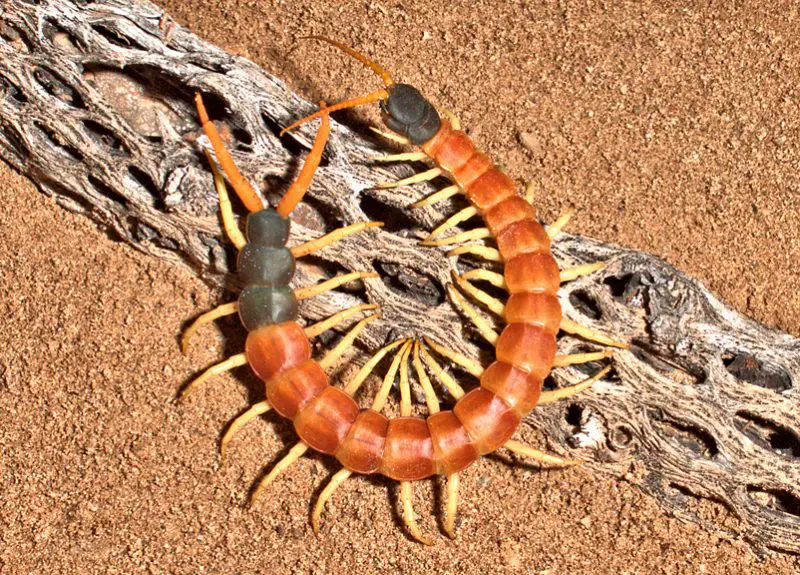
The Giant Desert Centipede, Scolopendra heros, is one of the largest centipedes found in North America, reaching lengths up to 6 to 8 inches (15–20 cm). Its body is robust and vividly colored, often featuring a deep reddish-brown head with a yellow-orange midsection and dark purple or brown rear segments. This striking coloration helps in identification and warns predators of its venomous nature. The many segments each bear a pair of long legs that give it a swift and agile movement.
This centipede is famous for its powerful venomous bite, which it uses to subdue prey such as insects, spiders, small reptiles, and even small mammals. While its venom is not deadly to humans, it can cause significant pain, swelling, and localized tissue damage. The Giant Desert Centipede is nocturnal, actively hunting at night and hiding during the day under rocks, logs, or in burrows to avoid the harsh Texas sun.
Scolopendra heros inhabits the arid and semi-arid regions of Texas, particularly in the southern and western parts of the state, including desert-like environments and scrublands. It prefers dry, sheltered places with loose soil or debris to hide in. Its distribution aligns closely with the Chihuahuan Desert region, where the climate is hot and dry, providing an ideal environment for this species.
Behaviorally, this centipede is aggressive when threatened, capable of delivering a defensive bite with its large, curved forcipules (modified front legs). It is a solitary hunter relying on speed and venom rather than camouflage. Despite its intimidating appearance and venomous bite, it plays a crucial ecological role by controlling populations of pest insects and other small invertebrates in Texas habitats.
Scolopendra polymorpha (Tiger Centipede)
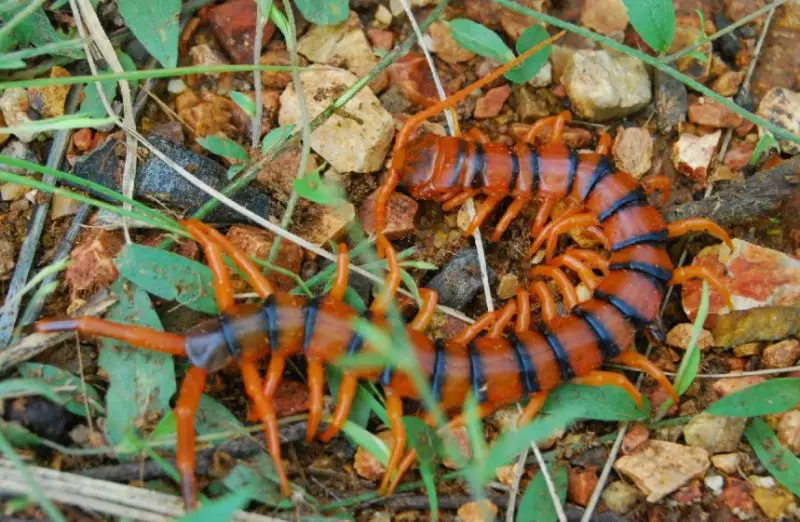
The Tiger Centipede, Scolopendra polymorpha, is easily recognized by its bold and striking coloration, usually featuring alternating black and yellow or orange bands along its body, reminiscent of a tiger’s stripes. It generally grows between 4 to 6 inches (10–15 cm) in length. Its body is elongated and flattened, with 21 to 23 pairs of legs that enable rapid movement and adept hunting skills. The contrasting colors serve as aposematic signals to potential predators.
This centipede has a potent venom that it uses to capture prey such as insects, spiders, and small lizards. While its bite is painful to humans and can cause swelling, it is rarely dangerous beyond localized symptoms. The Tiger Centipede is primarily nocturnal and hunts mostly at night, using its sensitive antennae to navigate and detect prey in the dark.
In Texas, Scolopendra polymorpha is commonly found in the arid and semi-arid southwestern regions, especially in deserts and rocky areas. It tends to hide under stones, logs, or leaf litter during the day to stay cool and moist. Its distribution overlaps with desert scrub and grassland ecosystems, thriving in the hot and dry climates typical of West Texas.
The Tiger Centipede is known for its defensive behavior; when disturbed, it raises its front legs and may strike quickly with its venomous claws. Despite its fierce reputation, it plays an essential role in the ecosystem by controlling insect populations. Its agility and venom make it an efficient predator in its harsh desert environment.
Scutigera coleoptrata (House Centipede)
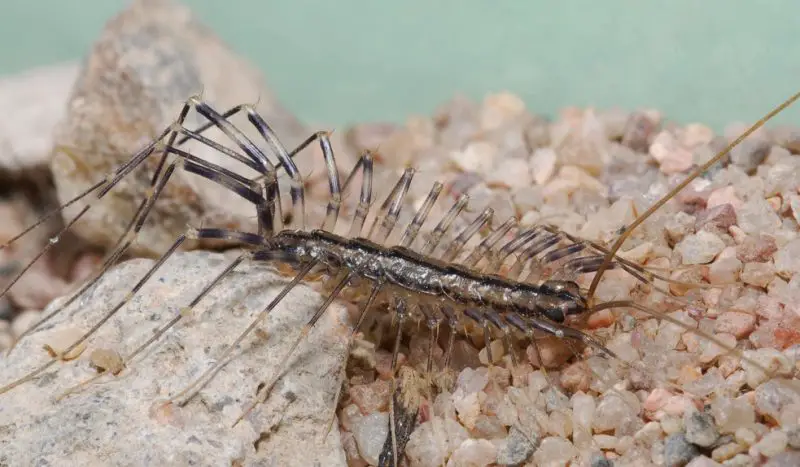
Scutigera coleoptrata, commonly known as the House Centipede, is easily distinguishable from other centipedes by its long, slender legs and fast movements. It typically measures 1.5 to 2 inches (3.8–5 cm) in length, with a yellowish-gray body marked by three dark dorsal stripes. The long antennae and legs, which can be up to three times the body length, give it a spider-like appearance, aiding in quick navigation and hunting.
This centipede is venomous, using its front legs modified into forcipules to immobilize prey, which primarily consists of household pests such as spiders, cockroaches, and silverfish. Its venom is harmless to humans, generally causing only minor irritation if bitten. The House Centipede is a beneficial predator indoors, helping control pest populations in homes and buildings.
In Texas, the House Centipede is widespread, especially in urban and suburban areas where it can find shelter and prey inside homes, basements, and crawl spaces. It prefers moist environments with dark hiding spots, often coming out at night to hunt. While it is commonly found throughout the state, it is more prevalent in areas where humidity is higher.
Behaviorally, the House Centipede is shy and avoids humans, fleeing rapidly when exposed to light or disturbance. It is mostly nocturnal and relies on its speed and long legs to catch prey quickly. Unlike many other centipedes, it does not burrow but rather stays close to its preferred moist microhabitats within human dwellings.
Scolopocryptops sexspinosus (Six-spined Centipede)
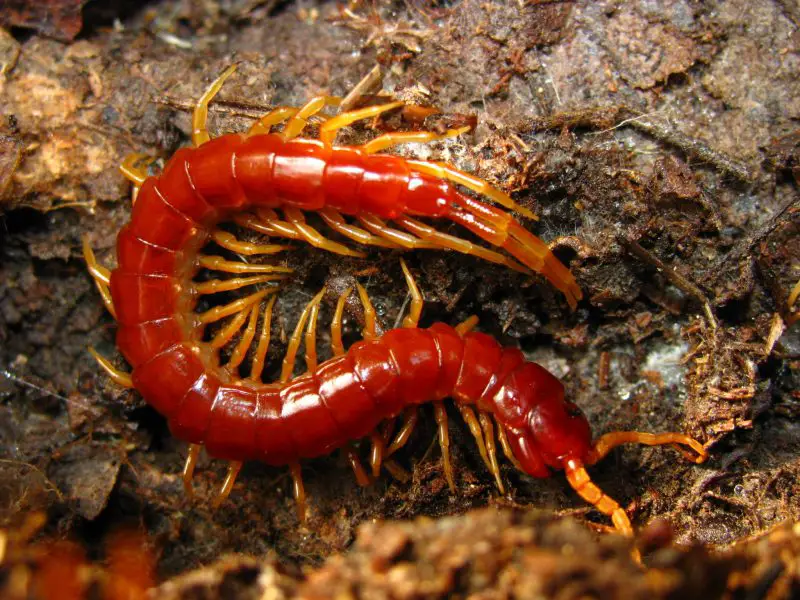
The Six-spined Centipede, Scolopocryptops sexspinosus, is a medium-sized species typically measuring around 3 to 4 inches (7.5–10 cm) in length. It has a flattened, reddish-brown body with 23 pairs of legs and six distinct spines or projections on the dorsal side, which is a key identification feature. Its body segments are relatively smooth, and its antennae are long and slender.
This species is venomous, using its forcipules to capture and immobilize prey such as insects, worms, and small arthropods. Although its bite can be painful to humans, it is not medically significant. The Six-spined Centipede is a nocturnal hunter, relying on stealth and speed to capture prey, often hiding under leaf litter, logs, or stones during the day.
In Texas, Scolopocryptops sexspinosus is found mostly in moist forested and woodland areas, favoring leaf litter and decaying wood in shaded environments. It is more common in the eastern and central parts of the state where humidity is higher compared to arid western regions. Its presence is an indicator of healthy soil and leaf litter ecosystems.
This centipede is generally reclusive and avoids confrontation. When disturbed, it will flee quickly rather than bite unless directly provoked. It plays an important ecological role by feeding on decomposer insects and helping regulate soil invertebrate populations, contributing to nutrient cycling in its habitats.
Thereuopoda clunifera (Flat-backed Centipede)
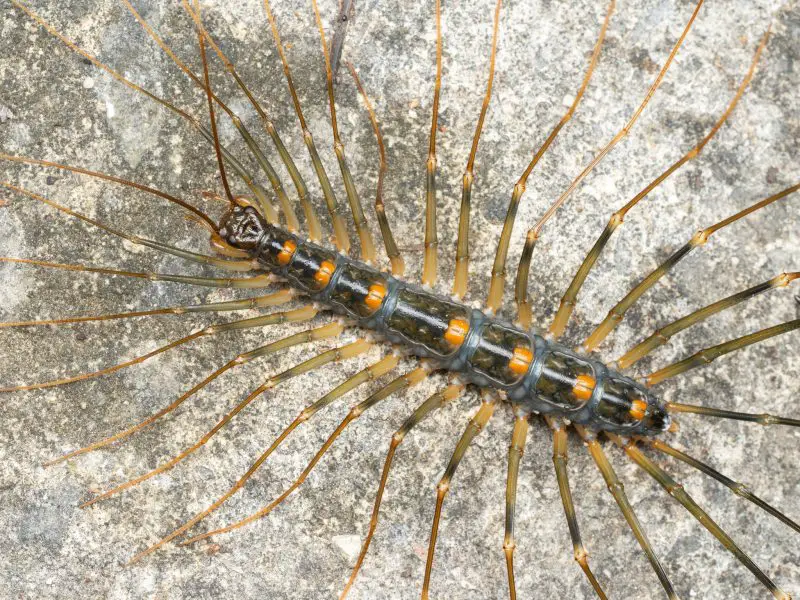
The Flat-backed Centipede, Thereuopoda clunifera, is characterized by its broad, flattened body and comparatively shorter legs compared to other centipedes. It usually measures about 2 to 3 inches (5–7.5 cm) in length. Its coloration ranges from yellowish to brown, often with darker markings or bands on its body segments. The dorsal surface is noticeably flattened, providing an easy way to distinguish it from more cylindrical centipedes.
This species has venomous forcipules used to subdue prey such as insects and spiders. The venom is not considered dangerous to humans, causing only mild pain or irritation if bitten. Thereuopoda clunifera is an active predator and typically hunts at night, using its flattened body to squeeze into narrow spaces in leaf litter, under bark, or inside rotting wood.
In Texas, this centipede is mostly found in moist, forested environments and woodlands, particularly in the eastern parts of the state where humidity levels support its survival. It prefers to live under leaf litter, bark, and fallen logs, playing a role in controlling invertebrate populations in these habitats.
Behaviorally, the Flat-backed Centipede is relatively shy and avoids confrontation. It uses its flattened shape for quick escapes into tight crevices. This centipede is important in maintaining the balance of soil ecosystems by preying on small arthropods and assisting in decomposition processes.
Mecistocephalus punctifrons (Texas Striped Centipede)
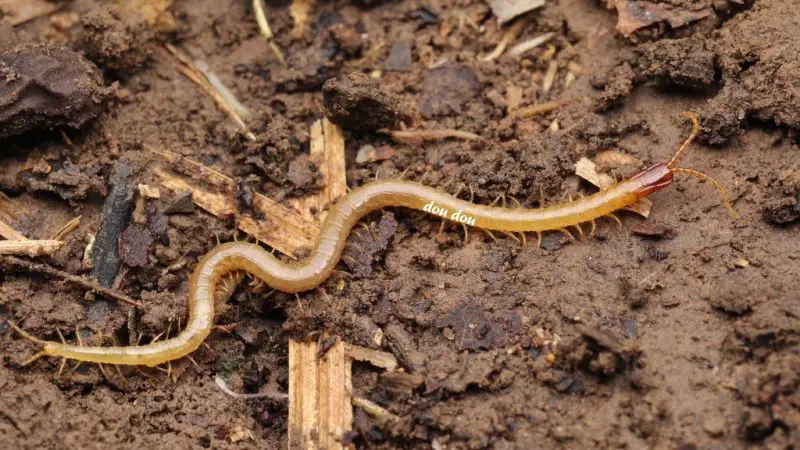
The Texas Striped Centipede, Mecistocephalus punctifrons, is a slender and elongated centipede known for its distinctive longitudinal stripes running down its body. It typically measures about 3 to 4 inches (7.5–10 cm) in length. Its body color varies from pale yellow to light brown, with darker stripes that make it easily recognizable. The numerous legs are long and thin, helping it navigate quickly through leaf litter and soil.
This species uses venomous forcipules to capture and subdue small prey such as insects and other arthropods. While its venom can cause mild pain or irritation to humans, it is generally not dangerous. The Texas Striped Centipede is primarily nocturnal, hunting during the night and hiding under rocks or debris during the day to avoid desiccation and predators.
In Texas, Mecistocephalus punctifrons inhabits moist environments like forests, grasslands, and shaded areas with ample leaf litter. It is mostly found in eastern and central regions of the state where humidity is higher and soil moisture is sufficient for its survival. This centipede thrives in microhabitats rich in organic matter.
Behaviorally, the Texas Striped Centipede is shy and elusive, relying on its speed and camouflage to evade threats. It rarely bites humans unless handled or provoked. Its role as a predator of soil insects makes it an important contributor to controlling pest populations and maintaining soil health.
Lithobius forficatus (Stone Centipede)
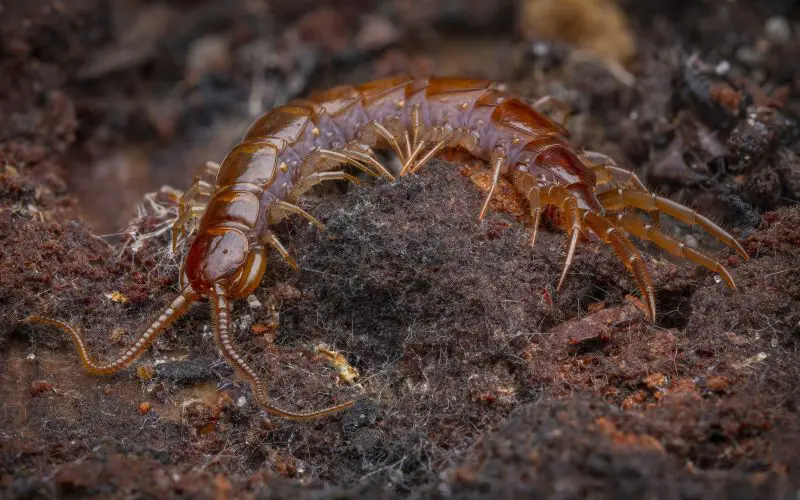
The Stone Centipede, Lithobius forficatus, is a robust, moderately sized centipede typically ranging from 1.5 to 2 inches (4–5 cm) in length. It has a flattened, segmented body colored dark brown to reddish-brown, with 15 pairs of legs that help it move rapidly over rocks and leaf litter. Its name comes from its common habitat among stones and rocky environments.
This centipede has venomous forcipules that it uses to immobilize prey such as insects, spiders, and other small arthropods. Its venom can cause localized pain and swelling in humans but is not medically serious. The Stone Centipede is mostly nocturnal and actively hunts at night while seeking shelter in crevices, under rocks, and logs during the day.
In Texas, Lithobius forficatus is more commonly found in the eastern woodlands and forested areas where leaf litter and stones provide shelter and hunting grounds. It prefers moist environments with stable microclimates. Its presence indicates healthy soil and balanced microfauna populations.
Behaviorally, this species is fast and aggressive when disturbed, capable of delivering a defensive bite. It plays a significant role in controlling insect populations in its habitat. Although not common in arid regions of Texas, it contributes to ecosystem health where conditions are suitable.
Rhysida longipes (Texas Brown Centipede)
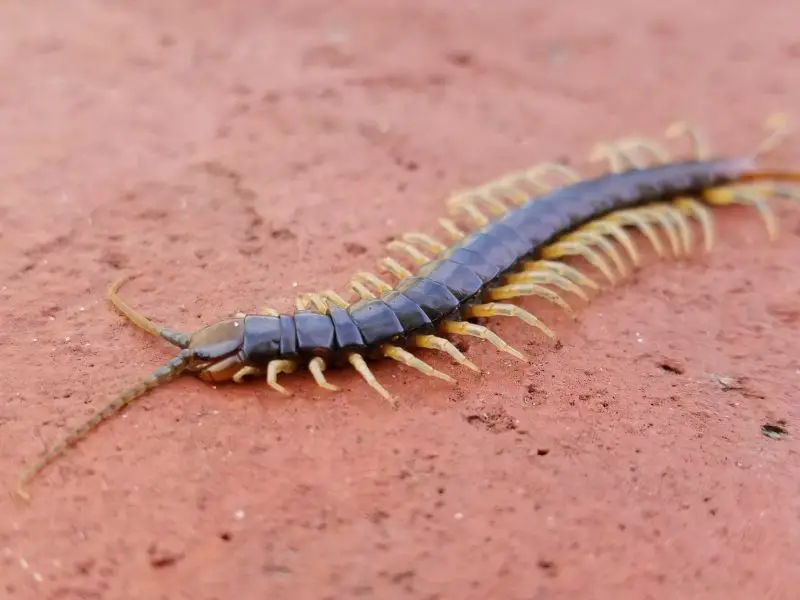
The Texas Brown Centipede, Rhysida longipes, is a slender, reddish-brown centipede that usually grows between 3 to 4.5 inches (7.5–11.5 cm) long. Its body is covered with numerous long legs that help it move swiftly and silently across the forest floor. It has a smooth, shiny exoskeleton with subtle segmentation that reflects its flexible, agile nature.
This species is venomous and uses its front forcipules to capture prey such as insects, spiders, and other small invertebrates. Its bite can cause mild pain and localized swelling in humans but is not dangerous. The Texas Brown Centipede is nocturnal, hiding in moist leaf litter, under bark, and within soil during the day.
Rhysida longipes is native to Texas and is mostly found in the eastern and central parts of the state, favoring humid, forested environments with abundant organic matter. It thrives in gardens, woodlands, and sometimes suburban areas where moisture and prey are plentiful.
Behaviorally, this centipede is a quick and efficient predator, relying on stealth and speed to hunt. It tends to avoid humans but will bite if provoked. Its ecological role includes regulating populations of soil-dwelling insects, helping maintain a balanced ecosystem.
Otostigmus spp. (Small Tropical Centipedes)
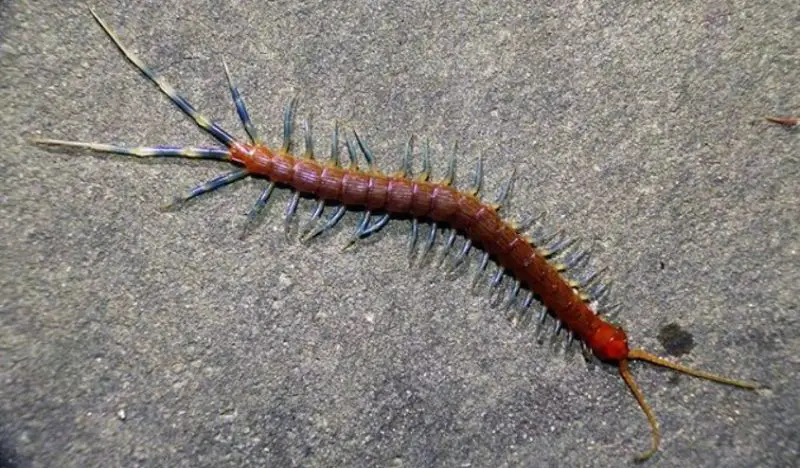
Centipedes of the genus Otostigmus are small to medium-sized tropical species characterized by a robust body, usually 2 to 4 inches (5–10 cm) long, and dark to reddish-brown coloration. They have a segmented, flattened body with 21 to 23 pairs of legs, and relatively short antennae compared to some other centipedes. Their body is sturdy and adapted for burrowing and moving through leaf litter.
Otostigmus species are venomous predators feeding on insects, spiders, and other small invertebrates. Their venom is potent for subduing prey but generally only causes mild pain or irritation in humans. These centipedes are mostly nocturnal, hiding in moist, shaded environments during the day.
In Texas, Otostigmus species are uncommon and mostly found in the warmer, more humid southern and southeastern parts of the state where subtropical conditions prevail. Their presence is often linked to tropical microhabitats or introduced populations. They prefer moist soil, leaf litter, and decaying wood as shelters.
Behaviorally, these centipedes are active hunters with quick movements and a tendency to flee when disturbed. They contribute to controlling populations of small invertebrates in their ecosystems and play a part in nutrient cycling through their predatory activities.
Alipes spp. (Feather-tailed Centipedes – rare in Texas)
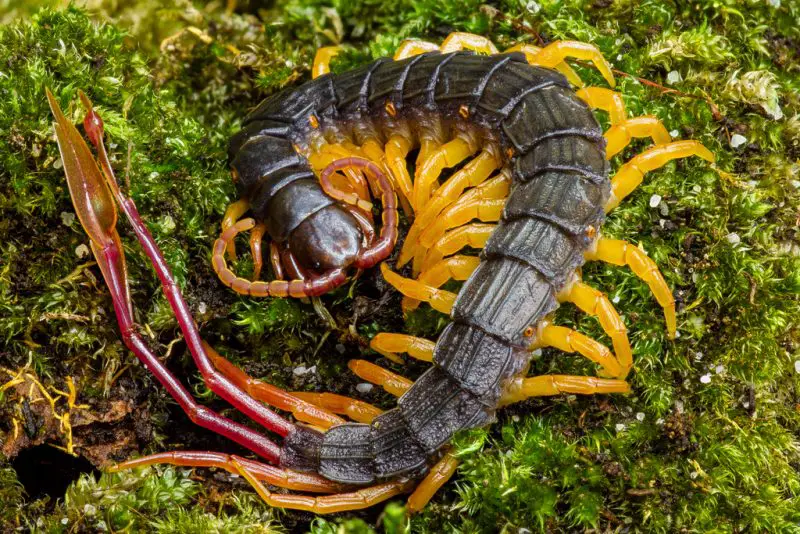
The Feather-tailed Centipedes of the genus Alipes are distinctive for their ornate, fan-like extensions on the rear legs, resembling feathers or fans. These appendages are thought to be used for defensive displays and can produce sounds by stridulation. They are medium-sized centipedes, typically measuring 3 to 5 inches (7.5–12.5 cm) in length, and exhibit striking coloration ranging from yellowish to dark brown with patterned markings.
These centipedes are venomous predators, using their forcipules to catch insects and other small arthropods. Their venom can cause painful bites but is generally not life-threatening to humans. Alipes species are mostly nocturnal and tend to hide under logs, leaf litter, or stones during the day.
Although native mostly to parts of Africa and tropical regions, some species of Alipes are considered rare or accidental visitors in Texas due to accidental introductions or trade. Their rarity in the state means their populations are limited and often restricted to controlled environments or isolated habitats.
Behaviorally, the Feather-tailed Centipedes are shy but can produce audible hissing or rattling sounds as a warning to predators by rubbing their feather-like appendages. Their unique defensive behavior and striking appearance make them fascinating but rare members of the Texas centipede fauna.
FAQs About Centipedes in Texas
What types of centipedes can be found in Texas?
Texas is home to various species of centipedes, including the Giant Desert Centipede (Scolopendra heros), Tiger Centipede (Scolopendra polymorpha), House Centipede (Scutigera coleoptrata), Six-spined Centipede (Scolopocryptops sexspinosus), and Texas Striped Centipede (Mecistocephalus punctifrons), among others. These species inhabit diverse environments ranging from deserts to forests and even urban homes.
Are centipede bites dangerous to humans?
Most centipede bites in Texas cause mild to moderate pain, swelling, and redness but are generally not life-threatening. Larger species like Scolopendra heros can deliver more painful bites, but severe allergic reactions are rare. Medical attention should be sought if symptoms worsen or signs of infection appear.
How can I identify a centipede?
Centipedes have elongated, segmented bodies with one pair of legs per segment. Species like the House Centipede have very long legs and fast movements, while others like the Giant Desert Centipede are robust with vivid coloration. Color patterns, size, number of legs, and habitat can help identify different centipede species in Texas.
Where do centipedes live in Texas?
Centipedes can be found in many habitats across Texas. Desert species like Scolopendra heros prefer arid southwestern regions, while species like Lithobius forficatus inhabit moist forests in eastern Texas. House Centipedes commonly live inside human dwellings, especially in damp areas such as basements and bathrooms.
Do centipedes help control pests?
Yes, centipedes are natural predators that feed on insects, spiders, and other small arthropods, helping to reduce pest populations. For example, House Centipedes prey on common household pests like cockroaches and silverfish, making them beneficial in controlling unwanted insects.
How can I prevent centipedes from entering my home?
To reduce centipede presence indoors, keep areas dry and free of clutter. Seal cracks and gaps around doors and windows, remove leaf litter or debris near the foundation, and reduce moisture by fixing leaks and using dehumidifiers. Removing other insects that centipedes feed on can also discourage their presence.
Are Feather-tailed Centipedes common in Texas?
Feather-tailed Centipedes (Alipes spp.) are rare in Texas and not native to the region. They are mostly found in tropical African regions. Occasional sightings in Texas might be due to accidental introductions but these centipedes are not established or common in the state.
Can centipedes climb walls or ceilings?
Yes, many centipede species, especially House Centipedes, are excellent climbers and can navigate walls and ceilings with ease. This ability helps them hunt prey in various locations, including inside homes.






